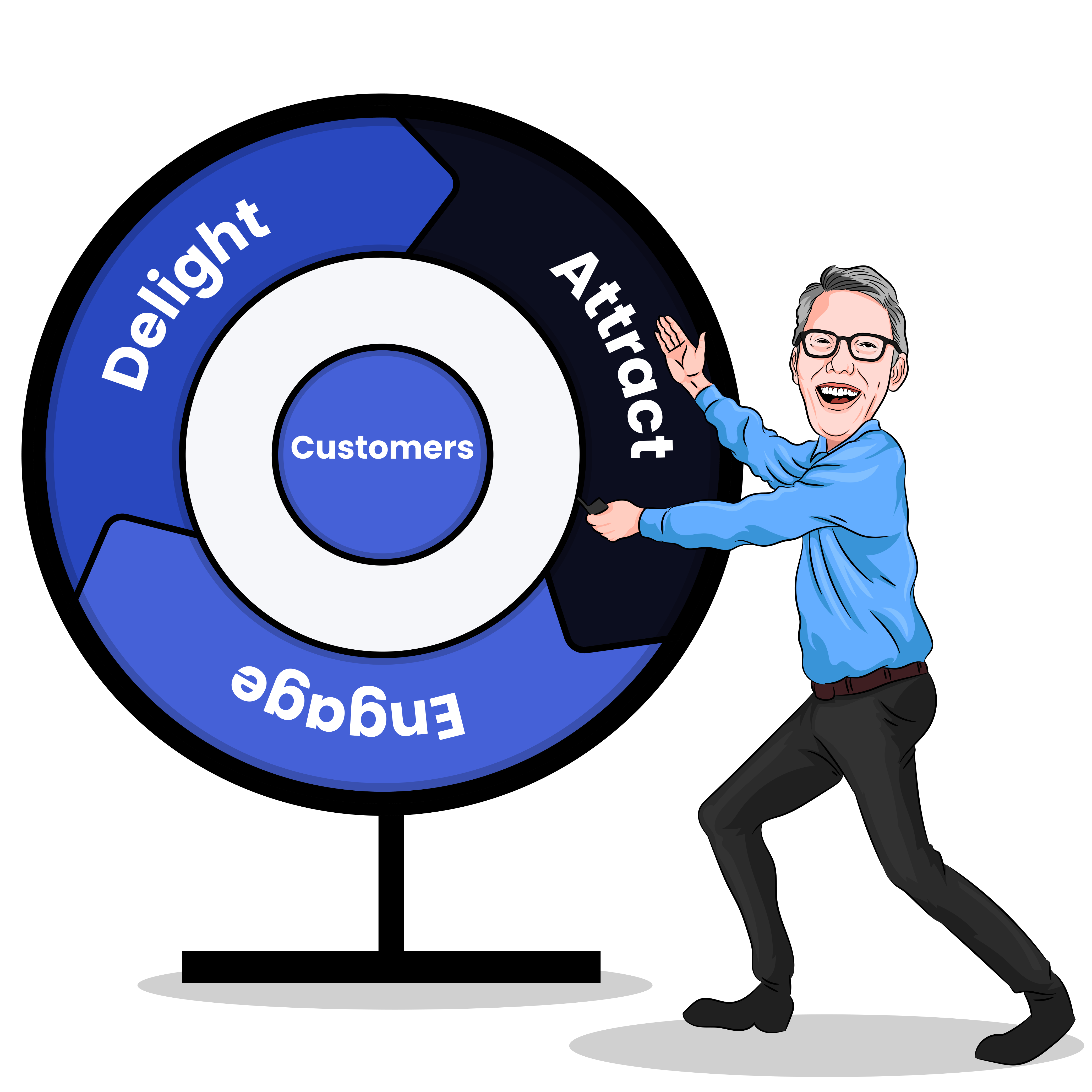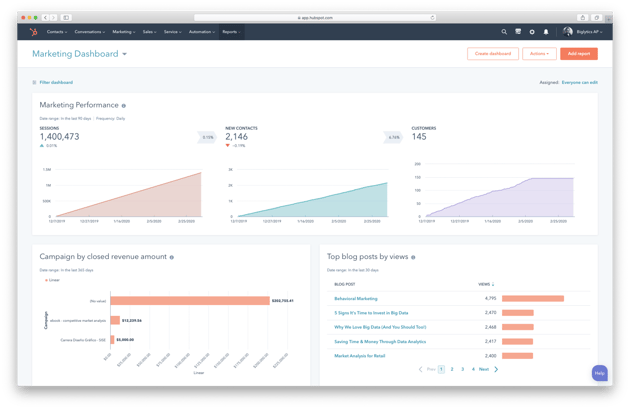Creating A Winning AI-Enhanced Inbound Marketing Strategy: A Step-by-Step Guide
-
Inbound marketing is a customer-centric approach that focuses on attracting, engaging, and delighting potential customers with valuable content.
-
The flywheel concept is key to inbound marketing success, emphasizing momentum, sustainability, and customer-centricity.
-
AI-driven inbound marketing strategies enhance personalization, efficiency, targeting, and ROI by utilizing technologies like NLP and machine learning.
-
Key steps to implement AI-driven inbound marketing include creating buyer personas, developing a tone of voice, and crafting a targeted content strategy across multiple channels.
-
Best practices for a sustainable AI-driven inbound marketing strategy include providing valuable content, incorporating chatbots, and integrating marketing automation tools.
Table of contents
- What is Inbound Marketing?
- The Secret Sauce of Inbound Marketing: Unlocking the Power of the Flywheel
- The Power Of AI In Inbound Marketing
- Step-by-Step Guide to Implementing AI-Driven Inbound Marketing
- Measuring And Optimizing Your Inbound Marketing Efforts
- Best Practices for a Sustainable Inbound Marketing Strategy
- Conclusion
What is Inbound Marketing?
Inbound marketing is a powerful approach that attracts and nurtures your audience with valuable content and creative experiences. Unlike traditional outbound marketing methods, inbound marketing focuses on being present where your audience is already searching for information.
By targeting the right people with valuable content, you build trust, credibility, and long-term loyalty, leading to higher conversion rates and delighted promoters of your brand.
Principles Of Inbound Marketing
-
Focus on the customer: Provide useful information instead of aggressive sales tactics.
-
Create valuable content: Address your audience's needs and pain points.
-
Use a multi-channel strategy: Reach customers through social media, email marketing, and blogs.
-
Develop buyer personas: Create detailed profiles of your ideal customers.
-
Align sales and marketing: Ensure both teams work together for a cohesive experience.
-
Measure success through data analysis: Track key metrics and make better decisions.

The Secret Sauce of Inbound Marketing: Unlocking the Power of the Flywheel
When it comes to inbound marketing, there's one concept that consistently proves to be the secret sauce behind every successful campaign: the flywheel.
The Flywheel: A Breakthrough Concept
The flywheel is a metaphorical, self-sustaining system that replaces the traditional funnel model. Unlike the funnel, which focuses on a linear process of converting leads to customers, the flywheel represents a continuous cycle of engagement, delight, and advocacy. Its built on three fundamental components: attract, engage, and delight.
-
Attract: In this phase, you draw in potential customers through targeted and valuable content, SEO optimization, and strategic social media presence.
-
Engage: Once you've attracted the right audience, it's time to engage them by providing valuable information, nurturing relationships, and addressing their pain points through your products or services.
-
Delight: The final step in the flywheel is delighting your customers, turning them into loyal advocates who will promote your brand and help attract new prospects.

Why the Flywheel Matters
The flywheel is essential to inbound marketing success for several reasons:
-
Momentum: As the flywheel spins, it gains momentum, representing the cumulative effect of your marketing efforts. The more you invest in attracting, engaging, and delighting your customers, the faster your flywheel spins, leading to exponential growth.
-
Sustainability: Unlike the funnel model, the flywheel encourages businesses to focus on long-term relationships with their customers. By prioritizing customer satisfaction and loyalty, the flywheel ensures a sustainable and organic growth in revenue.
-
Customer-centricity: The flywheel places the customer at its center, emphasizing the importance of providing value and outstanding experiences. This customer-centric approach helps businesses differentiate themselves from competitors and fosters strong brand loyalty.
Harnessing the Flywheel to Grow Revenue
To effectively use the flywheel in your inbound marketing strategy and boost revenue, consider these key steps:
-
Analyze and optimize: Regularly analyze your marketing efforts, identifying areas for improvement in each phase of the flywheel. Optimize your content, communication channels, and customer service to ensure a seamless and delightful customer journey.
-
Leverage customer feedback: Actively seek feedback from your customers and use it to refine your products or services, enhance customer experience, and tailor your marketing messages.
-
Empower customer advocacy: Encourage your satisfied customers to share their experiences and refer your brand to others. Use incentives, testimonials, and case studies to turn your customers into brand ambassadors and fuel the flywheel's momentum.
The Power Of AI In Inbound Marketing
Standing out from the crowd is no small feat. But what if there was a way to revolutionize your marketing strategy, amplifying your reach while minimizing effort? Introducing the next game-changer in the realm of digital marketing: AI-driven inbound strategies.
Embrace AI for a Competitive Edge
AI-driven inbound marketing combines NLP, machine learning, and other AI technologies to create personalized content tailored for your target audience.
Imagine analyzing customer data like never before, identifying patterns and creative ideas that even seasoned marketers might miss! With AI, you can create engaging social media posts, email subject lines, and blog articles that resonate strongly with potential customers.

Understanding Inbound Marketing And AI-Driven Strategies
Inbound marketing has changed the game in lead generation and customer relationship management. It focuses on attracting, engaging, and delighting potential customers with valuable content tailored to their needs and interests.
Now, let's couple inbound marketing with artificial intelligence. AI technologies allow you to analyze data quickly and generate insights that would be impossible for a human team.
Benefits Of AI In Marketing
AI has become a game-changer, providing numerous benefits for businesses of all sizes:
-
Personalization: Delight customers with tailored content and personalized interactions.
-
Efficiency: Automate processes related to predicting customer patterns and building customer profiles.
-
Improved targeting: Analyze and segment data for more effective targeting.
-
Better engagement: AI-enhanced chatbots respond to customer queries 24/7.
-
Increased ROI: Cost-effective digital ad placement generates better returns.
Step-by-Step Guide to Implementing AI-Driven Inbound Marketing
Creating Buyer Personas With AI
Accurate and detailed buyer personas are critical for any growth strategy. Not only will it help you understand your buyer, it'll also be a critical part when prompting as the results will increase with more specific details.
If you already have personas: If you already have personas created for your business and want to structure it in a suitable way to use in a ChatGPT promt you can use the following promt followed by pasting your current persona information:
"Please ingore any previous instructions. Now, help me create a highly effective prompt for the DAVINCI language model to be used with ChatGPT. I want you to compress the following information to reduce the amount of tokens without losing explanatory power. The information provided is for our target personas: ADD YOUR PERSONA INFORMATION HERE"
If you need to create personas: There are plenty of ways to generate new personas from the ground up, from pasting in information from your website to letting the language model developing it based on a keyword/service description. I'd recommend downloading the AIPRM-plugin to ChatGPT and browse their prompt examples.
Developing Your Tone of Voice
In addition to your persona, you need to develop your tone of voice. This will help the AI models tailor the content to your brand, and make it more unique.
The simplest way to generate this information is to paste in a few of your blog posts (or other copy) that is similar to the voice you want to have as a brand, and ask ChatGPT to create a brief description of the tone of voice of the aforementioned text.

Creating A Targeted Content Strategy
Leverage AI-powered tools such as ChatGPT, Jasper.ai, or Chat.ai combined with SEO tools like SurferSEO to streamline the content creation process and gain insights into customer preferences and behavior patterns. Make sure to develop a clear distribution plan across multiple channels, such as social media platforms and email marketing campaigns.
Developing an AI-Enhanced Content Calendar
Once you've defined your audience and tone of voice, you can start developing your content calendar. Use AI to identify what content resonates with your audience, and then schedule it for maximum impact. Tools like HubSpot's Content Strategy tool use to analyze customer behavior and suggest topics for future content. Remember to find the right balance between automation and human input; machines can identify patterns, but crafting compelling narratives still requires a human touch.
Crafting an AI-Driven Social Media Strategy
Social media is essential for any inbound strategy, and AI can make it even more effective. Use NLP to analyze past engagement data and create personalized social media posts for each customer segment. Chatbots can handle routine social interactions, freeing up your team's time for other tasks. By combining AI with strategic planning, you can elevate your social media outreach beyond simple posting schedules or promotions, generating qualified leads cost-effectively while maximizing resources.
Create Email Campaigns and Lead Magnets With AI
Once you've identified your target audience and created appealing content, engage them through AI-powered email campaigns and lead magnets. Personalized emails tailored to each customer's preferences increase campaign effectiveness. Use AI-generated lead magnets based on consumer behavior and preferences to attract potential customers by offering something valuable in exchange for their contact information.
Measuring And Optimizing Your Inbound Marketing Efforts
Measuring and optimizing your marketing efforts is vital to achieve the results you're looking for. With AI technology, you can easily analyze customer data and behavior, making data-driven decisions for optimization.
Key Metrics To Track And Analyze
Track and analyze these key metrics for marketing success:
-
Website Traffic: Number of visitors, their source, and duration on your site.
-
Lead Generation: Quantity and quality of leads from your marketing efforts.
-
Conversion Rates: Percentage of visitors taking desired actions on your website.
-
Engagement Metrics: Social media likes, shares, and comments.
-
Sales Metrics: Sales growth and revenue generated from your inbound efforts.
-
Customer Retention: Retention rates to assess long-term relationship building.
-
Cost Per Acquisition (CPA): Cost per lead or customer acquisition to maximize efficiency.
By tracking these metrics, you can make data-driven decisions for maximum impact.

Making Adjustments For Optimization
Regularly review and measure your strategy's effectiveness. Tracking metrics like website traffic, lead generation, and conversion rates helps identify areas for improvement.
Optimize your campaigns by incorporating personalization or experimenting with different approaches across channels like email marketing, social media, or SEO.
Continuous Learning And Adaptation
Stay ahead of the competition by continually learning and adapting your inbound strategy. Monitor performance metrics and tailor campaigns accordingly. AI can provide real-time feedback, like website heat maps or click-through rates.
Research trends in marketing technology, particularly advances in NLP for better targeting through chatbots or personalization engines.
Best Practices for a Sustainable Inbound Marketing Strategy
To create a successful marketing strategy, follow these best practices:
-
Provide valuable and relevant content that addresses your target audience's pain points and interests.
-
Incorporate chatbots to improve customer experience by addressing their needs quickly and efficiently.
-
Integrate marketing automation into your workflow to streamline processes and save time.
Providing Valuable and Relevant Content
To create a successful inbound marketing campaign, develop a targeted content strategy that delivers meaningful information across multiple channels. Use AI-generated or -prompted messages to provide personalized communication at each touchpoint in the customer journey.
Optimizing SEO with AI Tools
AI can simplify the complex task of SEO. They analyze customer data to create personalized content strategies that attract potential customers during the "attract stage" of the buyer's journey. Incorporate AI technology into your existing CRM systems to make data-driven decisions that improve ROI.
Using Personalization and Chatbots
Personalized content and chatbots help build strong relationships with potential customers. Implement chatbots on your website to provide instant responses, improving engagement and conversions.
Integrating Marketing Automation
Marketing automation can be a game-changer for your business. Streamline repetitive tasks like lead nurturing, email campaigns, and social media posting. Consider HubSpot's Automation Workflow feature for integrating marketing automation into your marketing strategy.
Frequently Asked Questions (FAQs)
How Can AI Improve My Inbound Marketing Strategy?
-
AI provides a deeper understanding of customer behavior and preferences.
-
Allows analysis of large amounts of data for deeper insights and personalized content.
-
Automates processes like lead scoring and segmentation, focusing on high-priority leads.
-
Identifies new opportunities for engagement and optimizes campaigns continuously.
How Do I Measure The Success Of My Inbound Marketing Campaign?
-
Understand key performance indicators (KPIs) and analytics.
-
Track KPIs like website traffic, lead generation and conversion rates, customer engagement, and social media reach.
-
AI-powered tools simplify this process by providing valuable insights into consumer behavior and other crucial metrics.
-
Analyze content performance in terms of traffic generation and lead capture rates.
Are There Any Ethical Concerns Regarding The Use Of AI In Marketing?
-
Concerns include manipulating consumer behavior and decisions without knowledge or consent.
-
Personalized data use raises questions about privacy and security.
-
When used properly, AI improves customer experience and helps businesses save time and resources.
Conclusion: The Future Of AI-Driven Inbound Marketing And Continued Success
In conclusion, an AI-enhanced marketing strategy can help marketers stay ahead of the game and deliver personalized content to their target audience. By using artificial intelligence tools, such as natural language processing and machine learning, marketers can create high-quality content, optimize SEO efforts and analyze customer data for better decision-making.
With a step-by-step guide from identifying the target audience to measuring success metrics continuously, businesses can build sustainable campaigns that generate leads cost-effectively.
The future of inbound marketing is ripe with opportunities for those who embrace AI-powered solutions and adapt their strategies to meet consumer preferences. As we move towards a tech-enabled era in the marketing world, those who harness the power of cutting-edge technology will undoubtedly come out on top.






